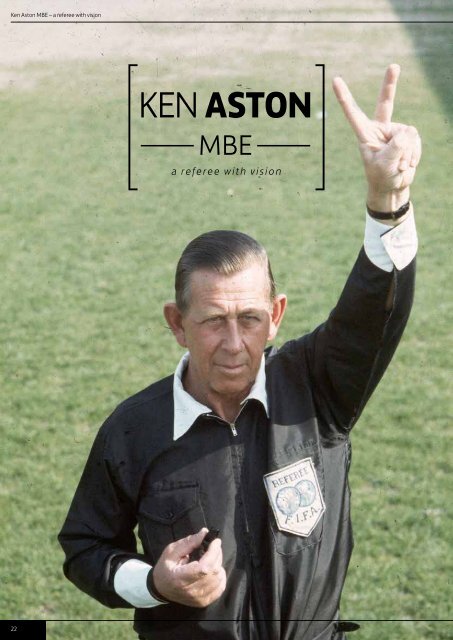Ken Aston MBE
10223_Referee-Magazine-Vol-26_LR
10223_Referee-Magazine-Vol-26_LR
- No tags were found...
You also want an ePaper? Increase the reach of your titles
YUMPU automatically turns print PDFs into web optimized ePapers that Google loves.
<strong>Ken</strong> <strong>Aston</strong> <strong>MBE</strong> – a referee with vision<br />
<strong>Ken</strong> aston<br />
<strong>MBE</strong><br />
a referee with vision<br />
<strong>Ken</strong> <strong>Aston</strong> in action in the Battle of Santiago, 1962<br />
<strong>Ken</strong> <strong>Aston</strong> was arguably one of the most<br />
influential refereeing figures of the<br />
20th Century.<br />
He qualified as a referee in 1936 and, following interruptions for World War 2 and military<br />
service, he became a Football League linesman (assistant referee) in 1949 and a Football<br />
League referee three years later.<br />
Over the course of the next decade he became one of the leading figures in world refereeing<br />
and officiated in the 1962 World Cup finals in Chile where he refereed one of the most infamous<br />
and violent matches in the tornament’s history - the so called ‘Battle of Santiago’ between the<br />
hosts, Chile, and Italy.<br />
Contemporary reports suggest that the build-up to the match was marred by derogatory<br />
comments from Italian journalists about Santiago, the capital, and the morality of the women<br />
in Chile. On the other side, the Chilean media commented negatively about the Italian team<br />
containing some players who had South America passports.<br />
All this led to a febrile atmosphere and the first caution was issued within seconds of the kickoff.<br />
After 12 minutes, <strong>Aston</strong> sent off Italy’s Giorgio Ferrini and needed armed police to remove<br />
him from the field. This set the tone for the remainder of the match which degenerated into<br />
regular brawls and violence, the like of which has never been seen since in the World Cup. To get<br />
a real flavour of what happened (and commentator David Coleman’s pungent criticism) it is<br />
well worth watching the highlights of the match on YouTube.<br />
Working at FIFA<br />
<strong>Aston</strong> suffered a strained Achilles and did not referee again in the World Cup but he was<br />
appointed to the FIFA Referees Committee which he served on for eight years – four of which<br />
were as Chairman.<br />
He was responsible for the referees at the 1966, 1970 and 1974 World Cup finals, which was<br />
not an easy job. In 1966 he had to go onto the field at Wembley when Rattin, the Argentina<br />
captain, was sent off by the German referee but refused to leave the field.<br />
In 1974 he was also involved in a major controversy when Jack Taylor was appointed to referee<br />
the final and it was alleged that the original choice, Bobby Davidson of Scotland, had lost out on<br />
the final after missing a bad foul when acting as a linesman in one of the semi-finals. FIFA did<br />
not appoint specialist linesmen until 1992 so referees at the World Cup finals sometimes had<br />
to ‘run the line’ even though many had not done so for many, many years.<br />
22<br />
23


